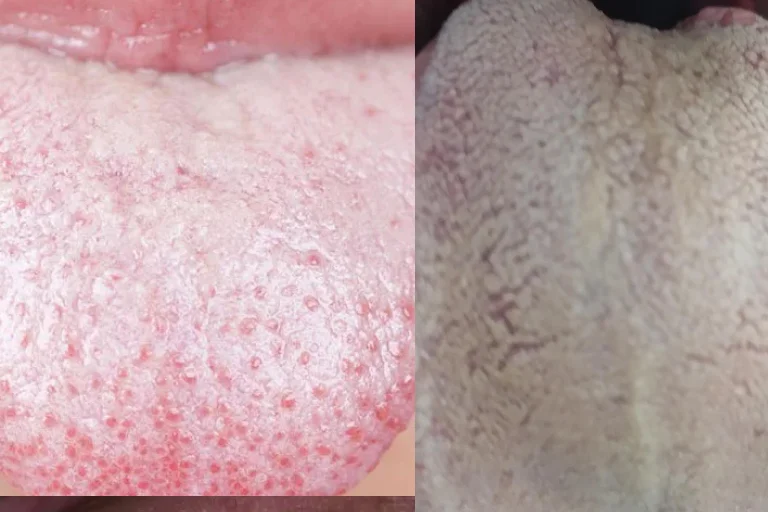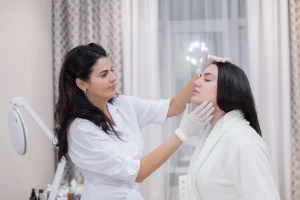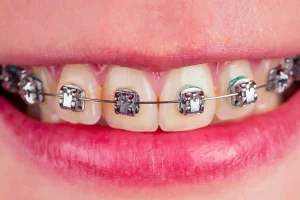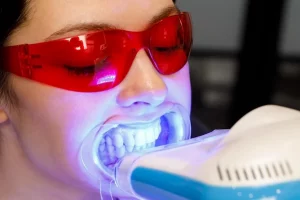Your tongue can reveal more about your health than you think. That pale pink surface is meant to stay clean, but when it develops a stubborn white coating, it’s often a sign your mouth needs attention. At Oris Dental Center in Dubai, we see this concern daily. Sometimes it’s just harmless buildup, other times it points to oral infections, vitamin deficiencies, or systemic conditions. Continue reading to know the difference as it is the key to keeping both your smile and your health in check.
What Is a Coated Tongue?
A healthy tongue is pale pink with tiny surface bumps called papillae. When food debris, bacteria, and dead cells settle between those papillae, the surface looks coated.
A thin white film in the morning is normal and usually fades with routine cleaning. A thick, persistent, or oddly colored coating that lingers beyond two weeks deserves a closer look.
Everyday Reasons Your Tongue Turns White
Oral hygiene lapses
If you skip brushing, flossing, or cleaning your tongue, you’re giving bacteria a free apartment lease. Up to 80% of oral bacteria sit on the tongue, not the teeth.
Dry mouth or dehydration
Saliva rinses the mouth naturally. When it’s in short supply, bacteria thrive. Medications, illness, or just not drinking enough water are common triggers.
Lifestyle factors
- Smoking and tobacco use irritate tissue and promote yeast growth. They also raise the risk of leukoplakia.
- Alcohol dries the mouth and disrupts the microbial balance.
- A soft, sugary diet leaves little natural “scraping” from fibrous foods.
- Mouth breathing, illness, or fasting All can reduce saliva and allow buildup.
Piercings
A new tongue piercing often carries a temporary coating. If it persists, infection is on the table.
When a White Tongue Signals Disease
Not every coating is innocent. Some point to pathology.
- Oral thrush: Creamy patches that wipe off, leaving red tissue, usually caused by Candida. Common in infants, immune-compromised patients, and those on antibiotics or steroids.
- Leukoplakia: Thick white plaques that don’t scrape off. Strongly linked to tobacco and alcohol. Sometimes a precursor to oral cancer.
- Oral lichen planus: Autoimmune inflammation with lace-like white streaks. Painful and often chronic.
- Geographic tongue: Map-like red and white patches that migrate. Harmless, though unsettling.
- Syphilis: Secondary syphilis may present with white oral lesions.
- Oral cancer: Rare, but persistent white patches, especially in smokers or heavy drinkers, need a biopsy.
- Psoriasis: Occasionally extends to the tongue.
- Systemic disease: Iron deficiency, B12 or folate deficiency, autoimmune disorders, and digestive disease can all alter tongue appearance.
What Other Tongue Colors Mean
- Yellow – Often hygiene issues, coffee or tea staining, or fungal growth. A deep yellow could suggest liver or bile duct problems.
- Red – Scarlet fever, Kawasaki disease, glossitis, or vitamin deficiency. A bright “strawberry” tongue should not be ignored.
- Brown – Heavy smokers, certain drugs, or chlorhexidine rinses.
- Green – Usually dietary, like parsley or food dyes.
- Purple or blue – Sometimes just blueberries, but can indicate low oxygen from lung or heart disease.
- Grey – Anemia, ulcers, or, rarely, typhus.
- Black hairy tongue – Overgrown papillae look like shaggy bristles. Poor hygiene, antibiotics, or immune issues are usual culprits.
Other Symptoms That Deserve Notice
White coating often travels with other oral complaints.
- Painful blisters or aphthae, often from stress, trauma, or deficiency.
- Burning sensations, especially in menopausal women with B-vitamin gaps.
- Swelling makes speech or swallowing difficult.
- Cracks and fissures that trap bacteria.
- Halitosis, almost always linked to tongue bacteria.
- Persistent dryness from reduced saliva.
A swollen tongue that suddenly blocks the airway is an emergency, not a dental problem.
When to Call a Professional
If the coating lasts longer than two weeks, worsens, or comes with pain, fever, or weight loss, book an exam. Dentists and physicians may order cultures or biopsies depending on the suspected cause. Visual inspection alone is often misleading.
How to Treat and Prevent a Coated Tongue
- Basic oral care: Brush gently twice daily, floss, and see a dentist twice a year. Replace your brush every three months.
- Tongue cleaning: A scraper is more effective than a toothbrush. Move from back to front, rinse, repeat. Skip scraping if you have lichen planus or psoriasis—it can worsen lesions.
- Hydration: Aim for at least 1.5 liters of water daily. Cut back on caffeine and alcohol.
- Quit irritants: Tobacco and alcohol both fuel coatings and cancer risk.
- Diet: Crunchy fruits and vegetables help keep the tongue surface clean. Ensure enough iron, zinc, and B vitamins.
Home remedies
- Saltwater rinses twice daily.
- Baking soda paste for neutralizing acids.
- Probiotics after antibiotics.
- Oil pulling with coconut oil if you enjoy old traditions
- Sugar-free gum with xylitol for saliva stimulation.
Medical treatment
Antifungals for thrush, antibiotics for syphilis, immunosuppressants for severe lichen planus, and surgical removal of precancerous lesions.
Life Stage Factors
Infants often show thrush. Pregnant women develop dry mouth more easily. Post-menopausal women are prone to burning mouth syndrome. Older adults with limited chewing need mechanical cleaning with scrapers. Certain drugs—antibiotics, corticosteroid inhalers, antihypertensives—can all shift the tongue’s appearance.
Stress and the Tongue
Chronic stress dampens immunity and flares autoimmune disease. It’s not in your head if psoriasis worsens when life gets rough. The tongue reflects it.
A Tool for Diagnosis
Healers have inspected tongues for centuries, and for good reason. Modern clinicians still use it as a quick health snapshot. It’s not foolproof, but ignoring it misses early signs of disease.
Takeaway
A coated tongue isn’t always cause for alarm, but it should never be ignored if it persists, causes discomfort, or looks unusual. Consistent oral hygiene, hydration, and lifestyle changes can keep most coatings at bay. When in doubt, let a professional take a closer look. At Oris Dental Center in Dubai, our team of specialists can diagnose the cause, treat it effectively, and restore confidence in your oral health.





